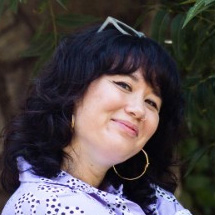Like many journalists-turned-marketers, Erika Heald discovered post-college that it was incredibly hard to make a living as a full-time journalist. Instead, she pivoted to creating all manner of in-house corporate content: newsletter editing, publication editing, managing editorial calendars, etc.
Nearly a decade ago, Erika recognized she was ready to go out on her own, leading to her fractional work as a chief content officer. She founded Erika Heald Marketing Consulting and now works to eliminate “random acts of content” for her clients.
What Is a Fractional Leader?
More and more leaders are calling themselves “fractional,” so let’s clarify what that means.
“I’m like the embedded chief content officer, without the company having to pay for a full-time executive and find enough for them to do to keep them excited about coming to work each day,” Erika explains.
Erika typically works on a weekly retainer. She puts together the content strategy and then helps with execution, and she can also manage employees, agencies, and freelancers. At the end of her engagement, she works to define the in-house role and helps interview and vet candidates for the job.
Sometimes, she even stays on for a short while to onboard the new hire and act as a mentor. When there are no other content folks in the company, that can be super helpful for new content leads.
Basically, fractional workers allow companies to benefit from a leader’s expertise while not assuming the risk of hiring that person full time.
Fractional Roles = Freedom
Erika enjoys working in a fractional capacity because she can simultaneously work with very different clients. She now has greater freedom to choose who she works with, and she can direct her own learning and growth trajectories.
“I really like the cross-pollination of working with different companies,” she admits. “So maybe one company will be SaaS software, and the other will be something that’s colocation. I have a tendency to do just B2B tech, so they’ll be technology-related on both sides, but very different industries, concerns, and content.”
Because the companies are different, Erika can learn from what’s worked (and not worked) for each and then use that to generate new ideas for other companies. And, because she’s not in-house, she finally has time to attend conferences, book speaking engagements, and build her own network.
“When a client has a problem, I know the right people to fix it. I know who we need to talk to, and a lot of it is because I have that freedom to be out there. When I had in-house roles, I barely had the chance to attend a conference — and if I did, frequently I couldn’t even sit through the sessions because there’d be an emergency I had to go take care of.”
Why Your Leaders Aren’t Always the Best Thought Leaders
As a fractional leader, one thing Erika’s passionate about is helping clients grow a strong thought leadership presence—and that starts with selecting the right people.
When you’re developing a thought leadership strategy, it’s natural to immediately think about your leadership team as a go-to source. However, Erika recommends looking elsewhere.
“Your CEO and other leaders have a lot of work to do,” she emphasizes. “I do a lot of executive ghostwriting, and it’s nearly impossible to get on the CEO’s calendar to have an intake call and talk about a piece of content you’re creating for them.”
Why does this matter? Isn’t it the ghostwriter’s job to take care of the entire piece?
When creating impactful thought leadership, you need a distinct POV from someone with experience and credibility. While you can outsource the writing, you can’t expect a ghostwriter to understand the detailed ins and outs of another person’s lived experience.
This means the thought leader involved must be present. They have to commit to providing the source material and engage with it after it goes live to amplify its reach. There’s nothing worse than posting on LinkedIn and having no one from the company interact with the content!
Since your execs are likely too busy, don’t start there. Good candidates for thought leadership are your internal folks who have great ideas around the content themes you want to be known for. Who are the people in your company who are already creating content? Who has a solid understanding of the issues your customers face — and opinions about how to solve them?
“Those people are frequently the best ones to tap for thought leadership because they have a little more time,” Erika says. “They want to develop themselves and their careers, and they understand how important it is to build a personal brand. You’re more likely to get that time commitment from them and the ability to actually make it work over time because thought leadership is not one and done.”
Building a Differentiated Thought Leadership Profile
Once you’ve identified your thought leaders, do the work to build a differentiated profile.
Erika recommends starting with competitor content audits. Every industry has its specific issues, trends, and hot topics. You want to know which ones your competitors are already talking about so you can carve out the space you own. (That is, unless your brand is a challenger brand and the whole point is to challenge other companies’ POVs. These brands exist, but they aren’t the majority.)
Next, figure out what channels you’ll use to distribute your thought leadership content.
“You have to understand the platforms and ways of engaging that can really work for your thought leaders,” Erika points out. “There are people who are amazing speakers who cannot, for the life of them, write. There are others who are fantastic writers who hate being on video or speaking in public.”
And in order to get this info, you’ll have to get up close and personal with folks!
“I like to really sit down and have those conversations to find out what people want to be known for. What are they passionate about? Where do they want to grow? If you can tap into those things, then you can find the right activities to build their profiles.”
The First-Ever Managing Editor Homework Assignment!
PS: Here’s a little homework assignment, straight from Erika’s suggestions.
Visit the Perplexity AI tool and ask it what you (or a thought leader at your company) are known for. For example: “What is the content marketer Erika Heald known for?”
What this will reveal is whether or not you’re doing a good job building your personal brand. You should be getting results that include text and photos. You should see work you recognize and that you’re proud of.
See below for Erika’s results:

And if you’re not seeing similar results, that underscores the importance of the thought leadership content we just talked about. More homework for you, perhaps, but well worth it!






